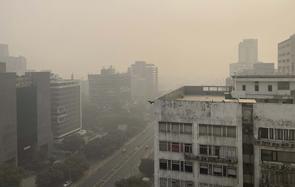 A bird flies with the horizon enveloped by smog and haze in New Delhi, India, Nov 4, 2022. (SHONAL GANGULY / AP)
A bird flies with the horizon enveloped by smog and haze in New Delhi, India, Nov 4, 2022. (SHONAL GANGULY / AP)
For more than a week the air quality in India's national capital, New Delhi, has again plummeted to alarming levels, though there was a slight improvement on Nov 6 when it was revised to the "very poor" category from "very severe".
Air quality index, or AQI, stood at 339 as of 4 pm on Nov 6, compared with 381 a day earlier, according to the System of Air Quality and Weather Forecasting And Research, a government project that monitors air pollution.
Several areas of New Delhi recorded an AQI in the "very poor" category, according to The Central Pollution Control Board, an agency under the federal environment ministry. AQI improved marginally on Nov 6 due to favorable wind speed and a drop in the contribution of stubble-burning in neighboring states, the CPCB said
Several areas of the national capital recorded an AQI in the "very poor" category, according to The Central Pollution Control Board, an agency under the federal environment ministry. AQI improved marginally on Nov 6 due to favorable wind speed and a drop in the contribution of stubble-burning in neighboring states, the CPCB said.
According to the agency, AQI between zero and 50 is considered "good", while a reading between 51 and 100 is deemed "satisfactory". AQI between 101 and 200 is deemed "moderate", while 201-300 range is "poor", 301-400 "very poor", and 401-500 "severe". A reading beyond 500 is severe plus emergency.
For three consecutive days AQI remained in "severe" category, jumping to 450 on Nov 3, more than 10 times the global safety threshold, according to the CPCB.
On Nov 4, the Delhi government asked people to work from home, schools were asked to stop outdoor activities, and traffic restrictions were put in place. Several schools moved classes online and some factories were ordered to temporarily shut down.
In order to fight the rising pollution, construction activities have been banned in the outskirts of Delhi from Nov 6, with hefty fines imposed for non-compliance. Delhi Chief Minister Arvind Kejriwal said his government is also contemplating reintroducing a traffic regulation wherein vehicles with number plates ending in odd or even numbers will be allowed on the road on alternate days.
An AQI near 400 can affect healthy people and seriously impact those with existing illnesses, health experts warn.
"We are not breathing air but smoking it," said Jyoti Pande Lavakare, an environmental activist in New Delhi.
A survey conducted by LocalCircles, an online community platform, has shown that four out of every five families in Delhi-NCR have claimed to have experienced pollution-related ailments in the last few weeks.
Rashmi Sama, a pulmonologist at Sir Ganga Ram Hospital in New Delhi, said the number of patients in the hospital due to respiratory and breathing problems and diseases related to rising levels of pollution has increased almost by 50 percent over the past few days.
Thick smog is enveloping monuments and high-rise buildings in and around New Delhi during early mornings.
Praveen Kumar, an autorickshaw driver in Connaught Place in central Delhi, complained that the haze was hurting his eyes and making it hard for him to breathe.
"We are more impacted than individuals in cars… We have to work; what can we do?" said Ramesh Thakur, another autorickshaw driver in the NCR.
READ MORE: India's Delhi shuts primary schools as air quality deteriorates
According to a study conducted in 2018 by The Energy and Resources Institute, a New Delhi-based non-profit research organization, vehicular emissions account for around 40 percent of the PM 2.5 pollution in the capital.
In 2019, air pollution killed more Indians than any other risk factor, according to government data. Most of the victims are children from poor families as they spend most of their lives outdoors.
Worsening air pollution has triggered political blame games between state governments and India's federal government.
Federal environment minister Bhupendra Yadav, from India's ruling Bharatiya Janata Party, or BJP — which serves as the opposition party in Delhi and Punjab states — blamed Punjab for its failure to stop the burning of crop residues, and the Delhi government for turning the capital into a "gas chamber".
The Aam Aadmi Party, a foe of the BJP, is in power in Punjab and Delhi.
Refuting the allegation, Punjab Chief minister Bhagwant Mann pointed out that his government took office only in March this year, and that the federal and state governments need to tackle the pollution crisis together.
Meanwhile, Mann and his Delhi counterpart, Kejriwal, pledged to curb the practice of crop residue burning by the next winter.
ALSO READ: Searches called off in India bridge collapse that killed 135
Stubble burning or burning of crop residues in northern India is a key contributor to the air pollution in New Delhi. With the start of the winter wheat-sowing season, practice of burning is rampant in the states of Punjab, Haryana, Uttar Pradesh and other adjoining states of New Delhi. Farmers in these regions usually find it cheaper to burn residues of harvested crops to clear the land for fresh plantation.
Punjab has recorded over 29,000 farm fires since Sept 15, with over 2,000 such fires reported per day since Nov 2. Haryana recorded 2,500 fires in the same period, according to the Indian Council of Agricultural Research.
The writer is a freelance journalist for China Daily.


